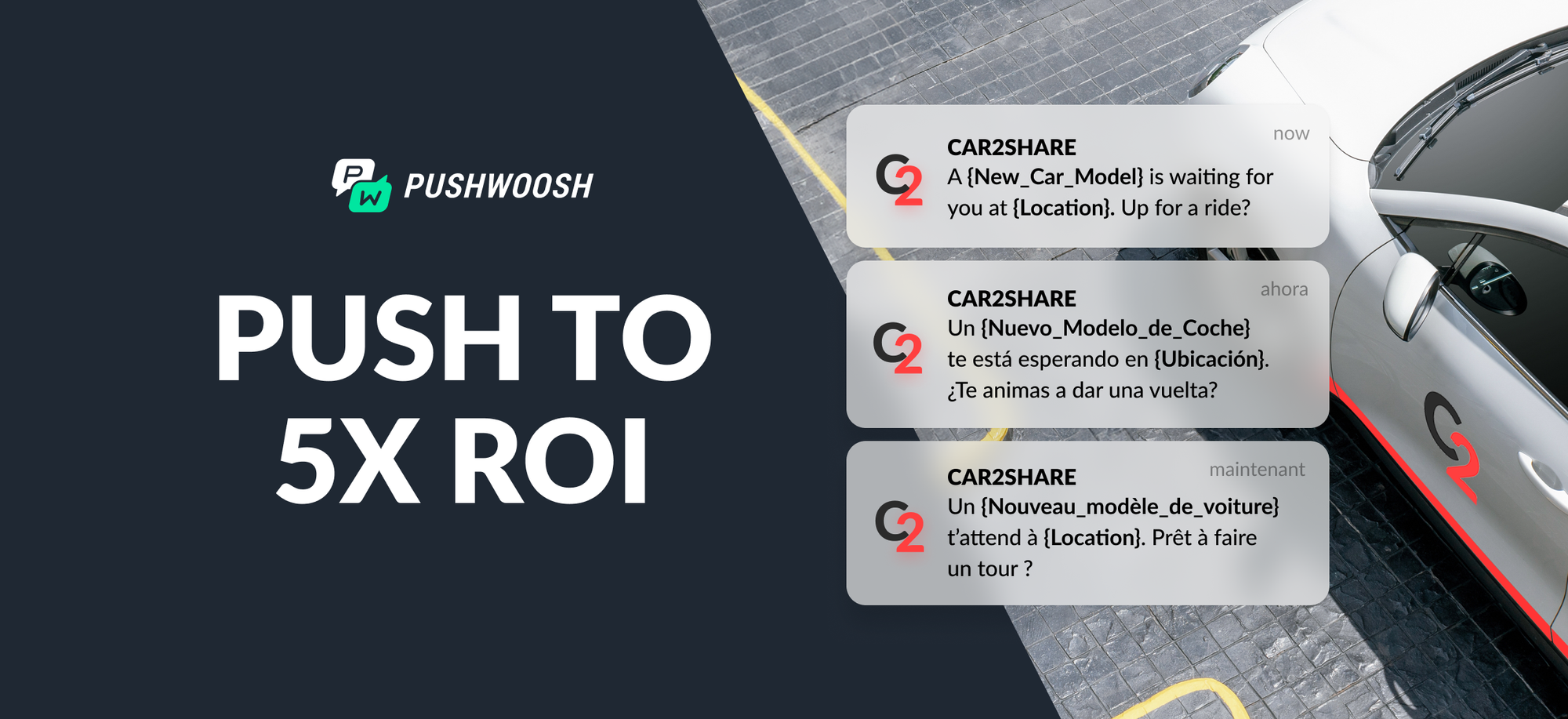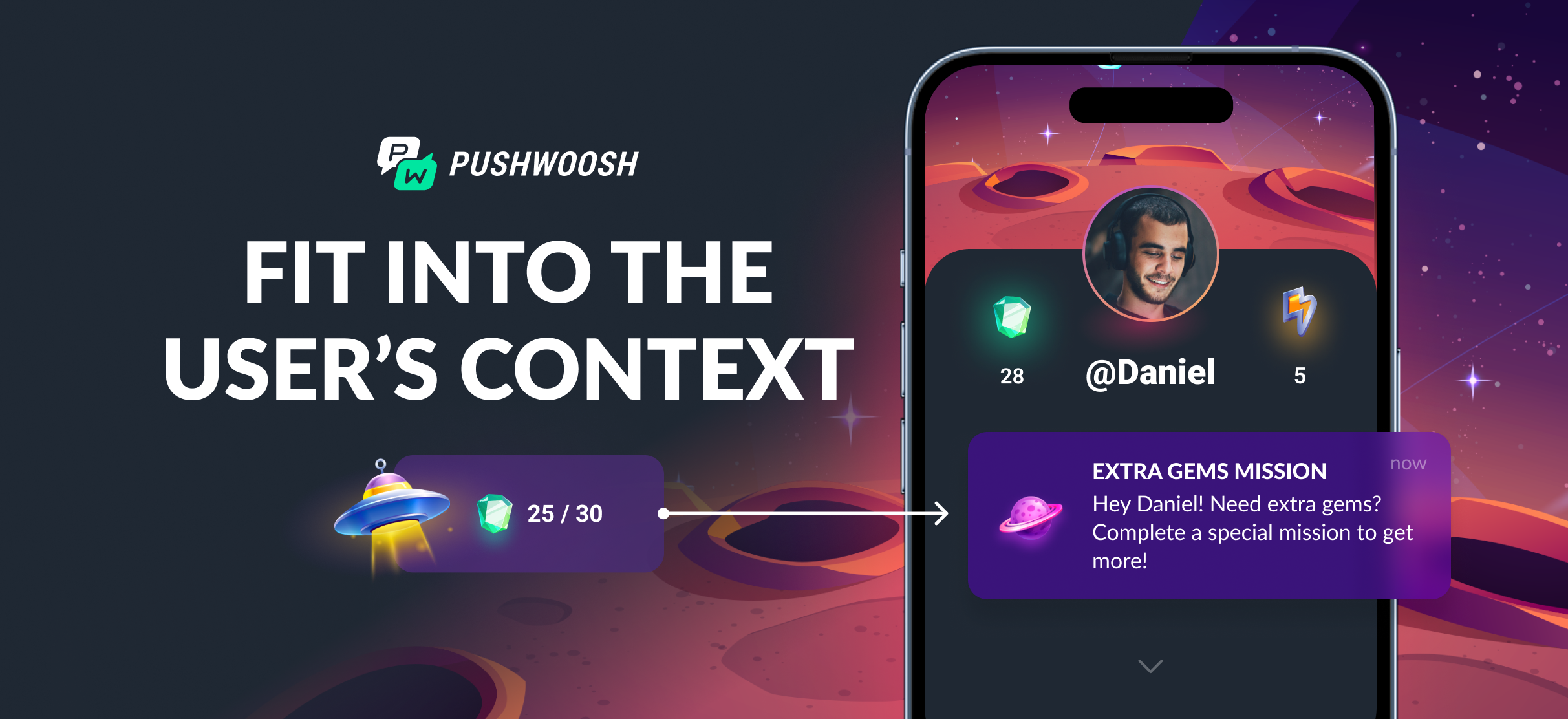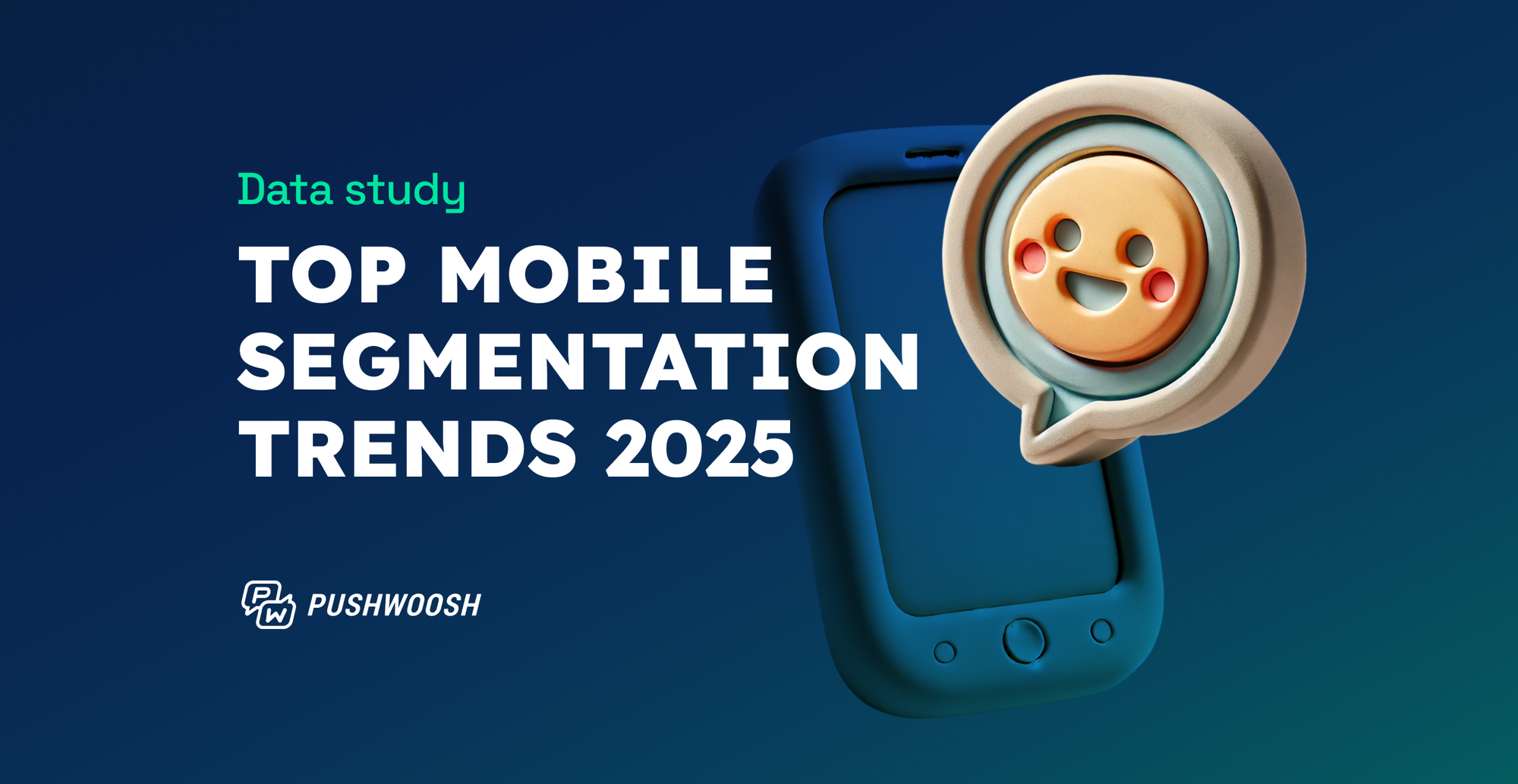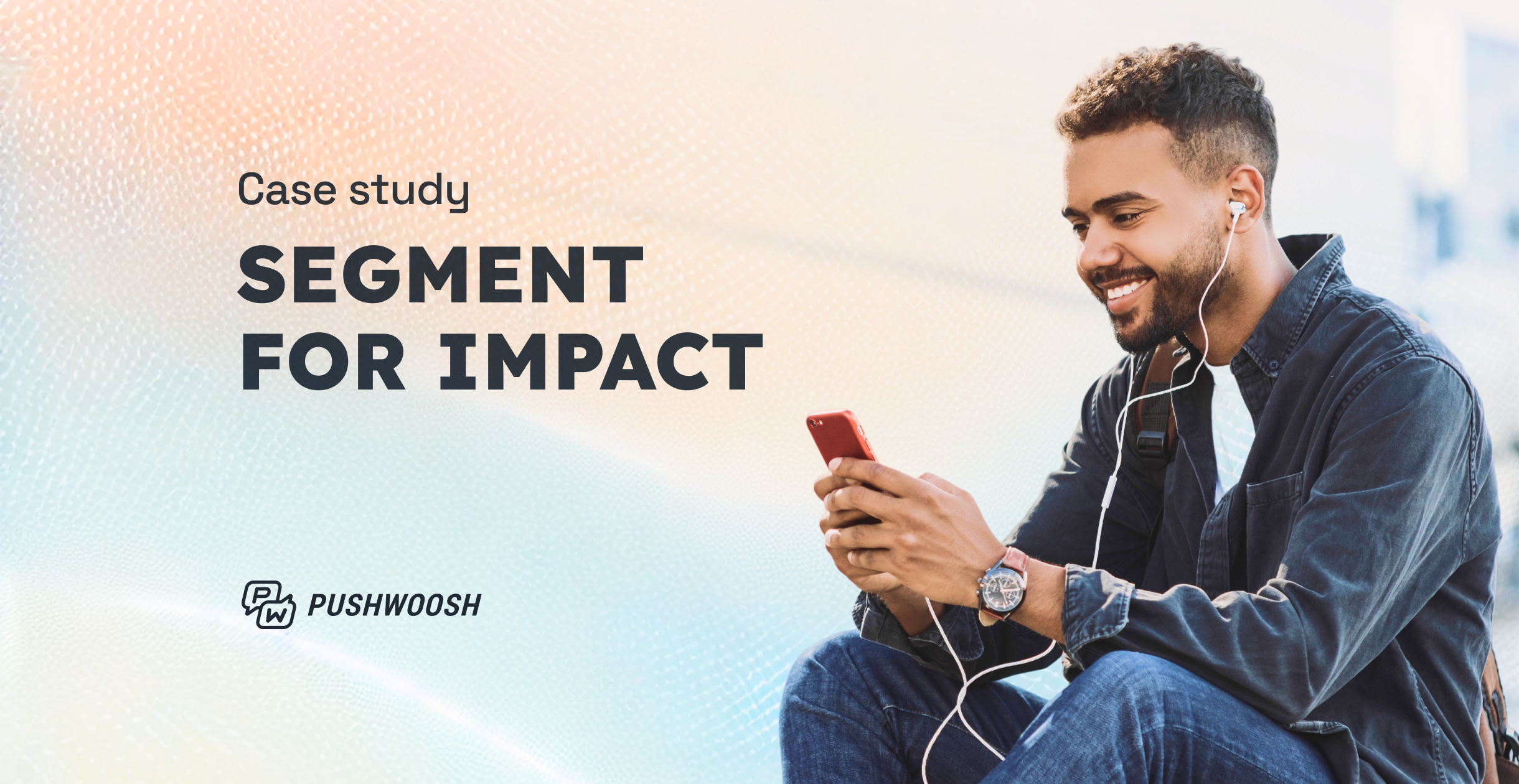Personalized push notifications: Your key to a 5X ROI
92% CTR, 3x more DAUs and MAUs, and direct conversions to sales. Sound like a dream come true? Well, it’s very much a reality for those who have mastered the magic of personalized push notifications. In this article, we’re going to break down how you can have even better results!
But first, let’s start with the basics.
What are personalized push notifications?
Personalized push notifications are communications tailored to a specific user based on data about their unique behaviors, preferences, or demographic data. Personalization is an effective tool for user engagement both on mobile and desktop devices.
Unlike generic push notifications that broadcast the same message to all users, personalized pushes leverage user-specific data to deliver relevant and contextually appropriate content that resonates on a personal level.
Here, it’s important to keep in mind that calling a user by their first name is no longer enough to win personalization. Instead, you should focus on their on- and off-site behaviors, demographic data, and purchase history.
For instance, a personalized push notification might reference their recent activities or offer deals based on their location or browsing history:
See how easy it is to miss the mark? But it’s not the only reason why personalization of your push campaigns is a worthy investment!
Why it is important to personalize push campaigns
Push notifications are generally a powerful tool for driving user engagement and retention. But personalized pushes take it a step further, significantly boosting your marketing effectiveness and user satisfaction.
The main benefits of push notifications personalization are:
- Higher user engagement: Personalized notifications are more likely to capture attention because they directly relate to user interests and past interactions. Bantoa reported a 91.9% CTR achieved thanks to push personalization.
- Increased user retention: Personalized pushes foster loyalty, encouraging users to continually engage with the app or website that understands them.
- Improved customer experience: Tailoring messages to individual users shows that a brand values their specific preferences, enhancing the overall perception of the brand and improving user satisfaction.
- Enhanced conversion rates: Personalized pushes drive users through the sales funnel by offering highly relevant offers and information, resulting in more conversions.
- Higher ROI: Multiple Pushwoosh case studies prove that personalization directly impacts ROI when used for promotional campaigns and loyalty programs (don’t worry, we’ll cover the specifics in a second).

Zahidul Alam Chowdhury
Head of Product at HungryNaki
Push notifications had a noticeable impact on our monetary metrics. We observed an increase in average order value as users were prompted to explore more products or services.
Additionally, customer lifetime value improved as engagement and retention increased due to the personalized push campaigns. We also noticed a rise in orders generated from a single push notification, indicating higher conversion rates.
5 bulletproof personalized push notifications campaigns’ examples
1. User activation and engagement
Push notifications can remind new users about key features, offer onboarding tips, or share exclusive deals. This personalized communication encourages initial engagement and helps users discover the product’s value, laying the foundation for long-term retention. You can segment users based on the stage of their onboarding journey or time communications based on their (in)activity with your app.
🌟 For example, Bantoa managed to register 28% of the users who downloaded the app but never signed up, thanks to push notifications’ personalization. While coming from e-commerce, this example is relevant to nearly any industry, as it serves as a non-invasive reminder about the user’s original intent for downloading the application.
2. Abandoned cart recovery

While we’re on the subject of e-commerce, we can’t skip one of the biggest use cases for push notifications—abandoned carts’ recovery. By mastering push campaigns’ personalization, you can drive customers to complete their purchases with personalized discounts, timely reminders, or unique upselling opportunities.
With Pushwoosh, you can set up extra-focused segmentation based on users’ activity or engagement level. For example, you can contact your more active users an hour after the intended purchase or wait for as long as a week before you reach out to those who haven’t interacted with your app in three days or more. The trick is to be in your customer’s mindset, and with data-driven personalization it has never been easier!
3. Customer retention and re-engagement

Online gaming is another industry where push notifications work like a charm. You can greatly boost your users’ engagement and retention rates by tailoring messages to individual player behavior.
For example, remind players about unfinished levels or upcoming events. Offer personalized incentives, like exclusive items or bonuses, based on their preferences and progress. Contextual notifications, such as when a player hasn’t logged in recently, can reignite their interest.
🌟Beach Bum Games grew their DAU and MAU metrics 3x after personalizing their push notification campaigns. They personalized the content of their communications based on the users’ in-game activity and their language preferences for the best results.
4. Transactional notifications
Many industries depend on timely, personalized transactional communications. However, in fintech, it may be particularly tricky. There are simply too many factors that need to be accurately reflected in such a campaign, like stock exchange data, price changes, positions closed at a specific rate, etc. That’s why the personalization of push notifications is a decisive factor for traders selecting their platform of choice.
🌟 Another Pushwoosh customer, AvaTrade, leveraged dynamic content personalization to achieve 9.4x the average CTR for fintech applications. They enhanced their notifications with personalized parameters of all the crucial metrics, such as order size, trade size, closing rate, protection type, and more, to ensure the user only receives the most specific alerts.
5. Customer loyalty programs
If you offer loyalty programs, personalized push notifications can be a great way to foster meaningful connections with your users, enhance customer satisfaction, and drive more clients to your business through referrals. Personalize your communications based on the user’s engagement, number of points or referrals, tier level, current savings, etc.
🌟 Omada has been leveraging Pushwoosh personalized notifications to drive customer loyalty, among other campaigns, and witnessed that up to 3.6% of users complete an intent action in their loyalty campaigns thanks to personalization.
Now, let’s see how you can make sure your next push campaign is as effective as it can be.
Best practices for push notifications personalization
Here are some tips to make sure your next personalization campaign goes without a hitch.
1. Personalize experiences, not names
Hey, {first.name}! Did you know that this is a sparkling example of superficial personalization? Truly personalized experiences consider user behavior, purchasing history, and preferences derived from data analysis. And your campaign’s results will be way more impressive if you appeal to a user’s experience with your platform even if you skip their first name altogether.
2. Always remember about data privacy
Adhering to data privacy laws and user preferences is paramount in digital marketing. Transparently communicate what data you collect and how it’s used to avoid issues and ensure the best customer experience.
🔏Learn how Pushwoosh addresses data privacy here.
3. Send only relevant messages
A push for the sake of a push is a failed strategy. Yet, many marketers continue to bombard users with irrelevant product recommendations, which can lead to notification fatigue. Instead, carefully analyze user behavior to send notifications that will be relevant to their experience with your platform and watch your ROI grow!
4. Don’t ignore web push notifications
When thinking of “push notifications”, most marketers automatically think of mobile apps. Yet, web push notifications extend the reach of your mobile campaigns, engaging a broader audience. True, web pushes won’t work for every industry; however, many niches, like media or e-commerce, see substantial benefits in reaching their contacts through desktops.
5. Test everything
A/B testing different messages, timings, and segmentation strategies helps understand what resonates best with your audience. And don’t just limit yourself to two options! Experiment with multiple variations of your campaigns to optimize it for the best outcome thanks to A/B/n testing.
6. Always be ready to adjust
Stay agile in your strategy by continuously analyzing your campaigns’ performance. And always be ready to pivot based on user feedback and changing trends. Notice a change in user behavior? It may be a good time to revisit your customer journey, tag them as a contact likely to bounce, and take action before the reaction is needed!
How does personalization work? Get started in a few steps!
Now, it’s time to get technical. While achieving high-level personalization may seem like a daunting task, it is actually not that difficult, as long as you have the right toolset.
Usually, the stack you should aim for needs to include:
- A reliable customer data platform (CDP) you’ll use to collect, store, and analyze customer data;
- A behavioral segmentation engine that will allow you to organize contacts into relevant groups based on their onsite behavior;
- Integrations with relevant third-party partners to analyze your users’ offsite behavior for an even more granular segmentation.
Fortunately, these come in neatly packaged solutions, such as Pushwoosh. We’ll be using our platform for references.
Explore Pushwoosh’s full potential on a demo
It all comes down to customer data
Make sure you have all the privacy settings set up correctly, your GDPR is impeccable, and users know exactly what you intend to do with their personal information.
Only focus on personal data that is valuable to your business (for example, if you’re in the travel industry, demographic factors like gender may be irrelevant to your campaign). Popular types of customer data include:
- Purchase history;
- Previous in-app searches;
- User preferences;
- Demographics.
But it’s not enough to find that data. You need to see how it all ties together to create a unified customer experience. Failing to do so results in fragmented and ineffective personalization, leading to lower performance results. Your goal is to bring all the data together to build a comprehensive customer profile for personalization.
Here, Pushwoosh acts as a CDP, collecting and unifying data from various customer touchpoints.
How to do it with Pushwoosh
Over the years, we’ve established that behavioral segmentation works best for your push campaigns’ personalization. You need to take a few technical steps to get started:
- Integrate Pushwoosh SDK with your app or website. As soon as it’s done, you can start capturing real-time user behavior through Default Tags and Events.
- Connect third-party partners to import your existing segments and data, enhancing behavioral segmentation further.
- Use Trigger-based or Audience-based entries to build tailored user journeys. Employ segmentation and split elements to cater communications to different subgroups.
- Customize further with Reachability checks to differentiate between users reachable via push or email. Track push openings to prompt follow-up messages for those who didn’t engage initially.
- Set up Custom Tags and Events for each user based on their activity to segment even deeper.
This setup allows for building personalized user journeys based on their behavior. Yet, you can personalize your messages even further with Dynamic Content and Liquid Templates functionalities. This way, your personalization opportunities become practically endless and you can go as granular as you’d like while also keeping your campaign automated.
Ready to try it for yourself?







